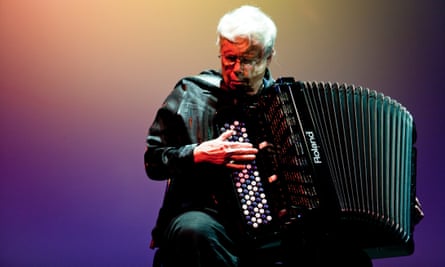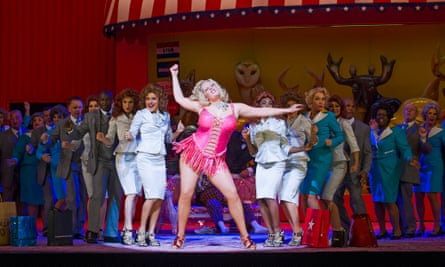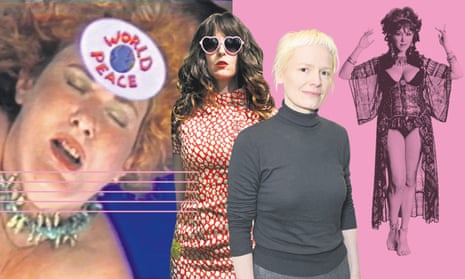In the early 1990s, the accordionist and musical improviser Pauline Oliveros wrote the soundtrack for a feminist porn film called The Sluts and Goddesses Video Workshop. The film is presented and co-directed by Annie Sprinkle, a sex worker turned academic whose lecture covers everything from deep breathing and vaginal bling to STD prevention and “mega orgasms”. Along the way, we get a spectacular sonic counterpart of drones, glitches, bleeps, twangs and pulsations.
Conventional porn music this is not: no sultry saxophones, no oily bass guitars. Instead, Oliveros made sounds that are fun, tactile and inquisitive. If Sprinkle’s mission was to confront industry standards of what erotic looks like, freeing viewers to define their own tastes, Oliveros reminded us that the power to decide what music means should ultimately belong to the listener.
This autumn, in the wake of the allegations against Harvey Weinstein and others, a couple of things became urgently clear. We must listen more carefully to women’s voices, and we must change the power structures that govern much of public and private life, including the arts.

“Pauline was empowering her listeners,” says the writer Ione, the late Oliveros’s partner and regular collaborator. “Sluts and Goddesses was not pornography, not if you mean the word in any pejorative or sleazy sense. It was about sexual freedom, showing that sexuality is a natural and wonderful thing for women. The sounds Pauline made were deeply sensual because they related to the body. Her music was always about the Earth, the body, being human, the cosmos.”
The film gets a rare public screening this week at the London contemporary music festival, in a section termed (brace yourself) New Intimacy. Contemporary music has a long and tetchy history of labels, schools and isms, almost all coined by programmers or academics rather than artists themselves. New Intimacy seems a cheeky throwback to the contentiously named New Complexity and New Simplicity movements of the 1980s.

There is a particular irony to the “new” bit, given several of the works at LCMF are three or four decades old. But what about the “intimacy”? “Modernism was about removing the body from art,” says festival director Igor Toronyi-Lalic. “About removing personal identity and prioritising science, abstraction and objectivity. With postmodernism, the body is reinserted into feminist art, queer theory. That is what’s at the heart of the New Intimacy movement.”
The series includes a work by Kajsa Magnarsson “for strap-on and electric guitar”; a piece by Claudia Molitor to be performed by audience members within their own mouths as they chew sweets, popcorn and crisps; and the 1965 film Fuses, in which Carolee Schneemann documents the most intimate moments of her relationship with composer James Tenney. Also in the mix is the pristine and ultra-sparse Second String Quartet by Wandelweiser composer Jürg Frey – music so stripped back and delicate it can start to feel febrile, like the tender stuff left exposed after some kind of sonic disrobing. Aesthetically, it’s probably the diametric opposite to the sparkly dildos and nipple tassels of the film, but maybe the point is how these works share a potential to empower and turn the attention back on audiences.
Claudia Molitor has been exploring the haptic in music for nearly two decades, and welcomes the wide scope of New Intimacy. “It’s a provocation, right? Most of the time, women aren’t supposed to express ourselves in certain ways because it’s considered unbecoming, so maybe it’s good to put something out there that is unbecoming. If it makes people uncomfortable, that’s all right. A lot of women spend quite a lot of their lives feeling uncomfortable. Anyway, it’s hardly new. Mozart said it with Cosi Fan Tutte: women have the same desires as men.”

Composer and performance artist Jennifer Walshe likewise uses her work to deal with gender and identity. Her confrontational 2003 music theatre piece, XXX Live Nude Girls, featured Barbie dolls in all manner of sexual positions and scenarios of abuse. “If you want to privilege the female gaze,” she says, “you have to privilege it at every level of production, right down to technical crews. Think of an opera like Anna Nicole.” This was a work by Mark-Anthony Turnage, about the Playboy star Anna Nicole Smith. “The librettist is a man, the composer is a man, the director was a man. Why aren’t women allowed to write their own stories?”
Walshe also questions the potential in New Intimacy for exploitation or plain voyeurism. “Sometimes I feel that women are forced into a position where they are only permitted to have a voice by articulating their most intimate details,” she says. “Memoirs by musicians like Viv Albertine, Kim Gordon, Carrie Brownstein, Kristin Hersh – all of which are books I love – get very deep into the personal in a way many memoirs by male musicians don’t.
“Is there the expectation that in telling their stories, they have to get into these details? That their stories are only worth being heard if they are explicit? Or, as women, is part of dealing with life being forced to deal with gender or sexuality in a way many of their male collaborators don’t have to, which means it’s only natural to talk about it?”
One lesson from Weinstein is that his alleged victims didn’t speak out because the industry granted him a power that robbed them of their agency. “We need to trust ourselves,” wrote Mona Chalabi in the Guardian. “The sickening allegations have reminded me just how important it is that we trust our instincts.”
This also applies to the danger of glorifying artists. For centuries, we built up personality cults around composers – made gods out of men like Mozart, Beethoven, Wagner, Britten and Stockhausen. These genius narratives might have let us believe we were accessing the divine when listening to Tristan und Isolde or Mittwoch aus Licht – and so feel somehow aggrandised by proxy – but if composers were supposed to be superhumanly talented, their means of production remained unattainable to the rest of us, and their behaviour potentially unaccountable. It was a recipe for alienation, for too much licence, for abuse.

“Pauline was very much not into all that,” Ione says. “All that genius crap. Just look at the collaborative, collegial, supportive way she worked with Annie and the group of women who made Sluts and Goddesses. Look at the way she improvised with anybody.”
It seems contemporary music is moving increasingly in that direction. Gone are the towering iconoclasts of the 20th century. Instead, programmers from Huddersfield contemporary music festival to Glasgow’s Counterflows to LCMF are looking to provide nimbler, more personal experiences.
“It’s about getting us to relate to ourselves better,” says Molitor, whose piece 10 Mouth Installationsincludes an instruction sheet suggesting the best order in which to eat the sweets, popcorn and crisps (Hula-Hoops to be precise). “It’s about not going for a big public statement where one person declares something and the audience laps it up. It’s more of a negotiation: I’m an individual, you’re an individual, so let’s all acknowledge our bodies and our presences in this space.”
If contemporary classical music seemed a branch of the avant-garde too erudite for everyday gender politics, too esoteric to deal with the erotic, think again. With its flexible forms, exploratory sound worlds and playful intellectual provocations, this music is proving to have a special potential to redress the way we relate to status, to each other, to ourselves – not only for those making music, but also for those listening.
- The London Contemporary music festival runs until 10 December; 10 Mouth Installations is on 7 December; The Sluts and Goddesses Video Workshopon 8 December.

Comments (…)
Sign in or create your Guardian account to join the discussion